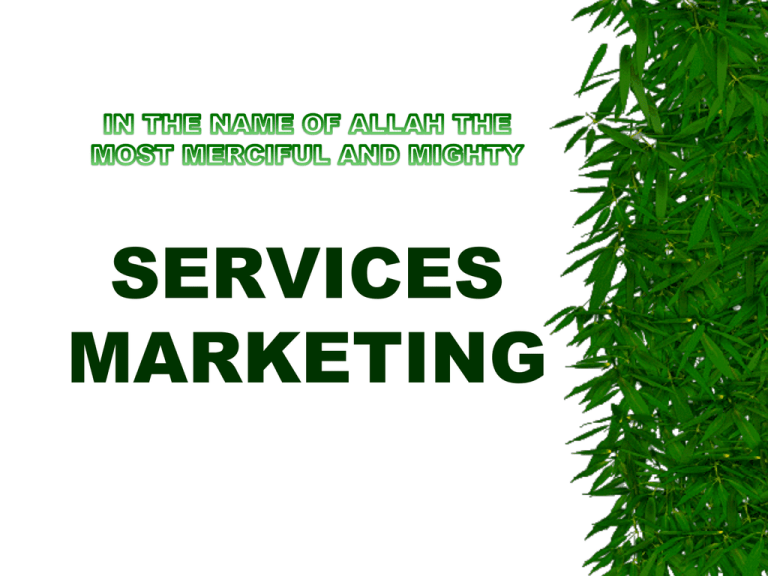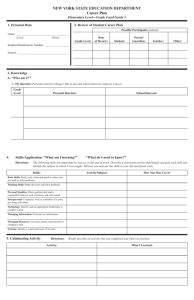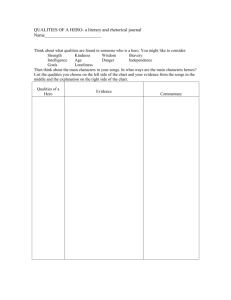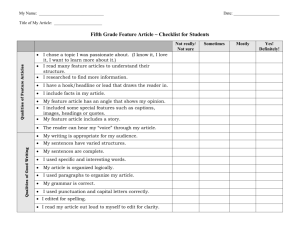Chapter_02
advertisement

SERVICES MARKETING CHAPTER 3 Consumer Behavior in SERVICES Consumer problem Time Deficiency For many customers, all types of shopping have become “drudgery or worse” Faced with dilemma, consumers have choices. They can continue to do all these tasks for themselves, or the can decide to employ the services of professionals or friends and relatives to help them out. The antidote to this time deficiency is found in many new services and service features that recover time for customers. Innovative new services pet sitting, plant watering, mail packaging, wedding advising, baby proofing, even health form preparation-are emerging to deal with tasks that used to be performed by the household but now can be purchased by the time buying consumer. Conventional services such as retailing, banking and restaurants are also adding peripheral services to make shopping easier, increasing their hours to suit customer schedules, reducing transaction time, improving delivery, and providing merchandise or services at home or work. Increased used of internet is also saving the time for customers. With the web and home delivery, many shopping tasks can be carried out by customers without even leaving the house and at any time of the day or night. SEARCH, EXPERIENCE, AND CREDENCE PROPERTIES There are three types of properties identified by economists for identifying goods and services. 1) Attributes that a consumer can determine before purchasing a product. Search qualities include color, price style, fit, feel, hardness and smell etc. Goods such as automobile , jewelry , clothing and furniture etc are high in search qualities because their attributes can almost be completely determined and evaluated before purchase. Attributes that can be judged only after purchasing or during consumption. Experience qualities include taste and entertainment etc. Goods and services such as vacations and restaurant meals etc are high in experience qualities because their attributes cannot be known and assessed until they have been purchased and consumed. A Third category credence qualities includes features that the consumer may find impossible to evaluate even after purchase and consumption. Examples of offerings high in credence qualities are appendix operations or brake relining on automobiles. Few consumers possess medical or mechanical skills sufficient to evaluate weather these services are necessarily and performed properly even after they have been prescribed and produced by the seller. CONSUMER CHOICES Following are the steps involved in consumer buying decision process: 1) Need recognition 2) Information search 3) Evaluation of alternatives 4) Purchase decision 5) Post purchase evaluation 1) Need recognition: The process of buying begins with the recognition that a need or want exists. Maslow gives the concept of five need categories arrange in a sequence from basic lower level need to higher level need. re biological needs such as food, water, and sleep. The recognition of these basic needs is fairly straightforward. Include shelter , protection ,and security. c) Are for affection , friendship and acceptance . Social needs are important in every culture but are particularly important in east. d) Are for prestige, success, accomplishment and self esteem. Food, safety and belonging are not enough for many people particularly in western culture. Individual also seek to look good to others and to feel good about themselves because of what they have accomplished. Involves self fulfillment and enrichment. Consumers desire to live up to their full potential and enjoy themselves. Some people purchase experiences such as skydiving, jungle safaris, and bungee jumping for the pure thrill of the experience, a need quite different from the others in Maslow’s hierarchy. The second step in consumer buying decision process is information search. Once they recognize a need, consumers obtain information about goods and services that might satisfy this need. When purchasing goods, Consumers collects information about products and services from personal sources (like friends or experts) and non personal sources ( such as mass or selective media and web sites) to gain information about goods and services. Seeking information is a way of reducing risk, helping consumers feel more confident about their choice. When purchasing goods , consumers make generous use of both personal and non personal sources because both effectively convey information about search qualities. When purchasing services, on the other hand, consumers seek and rely to a greater extent on personal sources for several reasons. ass and selective media can convey information about search qualities but can communicate little about experience qualities . By asking friends or experts about services, however, the customer can get information vicariously about experience qualities. non personal sources of information may not be available in services. Although some degree of perceived risk probably accompany all purchase transactions, more risk would appear to be involve in the purchase of services than in purchase of goods because services typically are more intangible and, non standardized and usually sold without guarantee and warranty. 1) The intangible nature of services and their high level of experience qualities imply that services generally must be selected on the basis of less pre purchase information than is the case of products. ecause services are non standardized , there will always be uncertainty about the outcome and consequences each time a service is purchased. 3) There is much perceived risk in services because there is no guarantee or warranty in services like in goods any services are so technical or specialized that consumers possess neither the knowledge nor experience to evaluate weather the services are good or not even after they have consumed the service. The third step in consumers buying decision process is evaluation of alternatives . After identification of alternatives the consumers will evaluate which alternative is the best one .The did cost and benefit analysis for making a choice. The evoked set of alternatives (that group of products a consumers considers acceptable option in a given product category ) is likely to be smaller with services than with goods. reason involve the differences in retailing between goods and services . To purchase goods the retailers shop in retail stores that display competing products in close proximity, clearly demonstrating the possible alternatives . To purchase services on the other hand, The consumers visit an establishment (such as bank , a dry cleaner , or a hair salon ) that almost always offers only a single brand for sale. continued A reason for the smaller evoked set is that consumers are unlikely to find more than one or two businesses providing the same services in a given geographic area, whereas in goods they find numerous retail store contains identical products. 4) Service purchase The fourth set of consumer buying decision process is decision and use. There can be two types of decisions , weather to buy or Not buy . If your decision is not to purchase then your buying decision will finished at this stage but if your decision is to purchase then their certain other decisions related to this purchase i.e. warranty and guarantee, mode of payment ,delivery related information. After that you will use the product. 5) Post purchase Evaluation: Attribution of dissatisfaction: when consumers are disappointed with purchase because the products did not fulfill the intended needs, did not perform satisfactorily or were not worth their price. They may attribute their dissatisfaction to a number of different sources, among them the producers, the retailers, or themselves. Because consumer participate to a greater to extent in the definition and production of services, they may feel more responsible for their dissatisfaction when they purchase services than when they purchase goods. continued Brand loyalty: The degree to which consumers are committed to particular brands of goods or services depends on a number of factors. The cost of changing brands (switching cost), the availability of substitutes, and the perceived risk associated with the purchase, and the degree to which they have obtained satisfaction in the past. Because it may be more costly to change brands of services, because awareness of substitutes is limited, and because higher risk may accompany services, consumers are more likely to remain customers of a particular companies with services than goods. The role of culture in services Culture : Culture is a set of symbols and traits created by society and handed down from generation to generation. The symbols may be intangible ( attitude, belief, values, language) or tangible ( tools, housing, products, works of arts ). Culture is learned, shared, and transmitted from generation to generation. Culture is important in service marketing because of its effects on the ways customers evaluate and use services. It also influences how companies and their services employees interact with customers. Culture is important when we consider international service marketing, taking the services from one country and offering them in other. Elements of culture 1) Values and attitudes Differ across Cultures: Values and attitudes help to determine what members of a culture think is right, important and or desirable .Because behaviors including consumer behaviors, flows from values and attitudes, service marketers who want their services adopted across cultures must understand these differences. 2) Manners and customs: Manners and customs represents a culture’s views of appropriate ways of behaving. It is important to monitor differences in manners and customs because they can have a direct effect on the service encounter. Continue 3) Material culture: Material culture consists of the tangible products of culture. What people own and how they use material possessions vary across world . Cars , houses , cloths , and furniture are examples of material culture. In Japan there are small houses because of the largest population. Japanese use small cages in the zoo for the animals and the people is USA uses large cages in zoo. If a US person visits the zoo in Japan so they will feel that this is a mistreatment while Japanese think that this small cage is enough for the animals . 4) Aesthetics : Refers to cultural ideas about beauty and good taste. These are reflected in music, art, drama, and dance, as well as appreciation of color and taste. Continue 5) Educational and social institutions: Both kinds of institution are affected by, and are transmission agents of, culture. The structure and functioning of each are heavily influenced by culture .Class room participation varies substantial across cultures. Japanese students are used to listen to lectures, taking notes and asking questions at the end of lectures. Spaniards are used to huge undergraduate classes ( Hundreds rather than dozens) they tend to talk to their friends even if the instructor is talking. Likewise the health care and patient /doctor interaction also varies across cultures. Difference in the service experience in united states and Japan Authenticity: In Japan “every clerk has the same type of smile…the smile is not natural ,”and ‘everything is done according to manual.” In united states, clerks “ act independently,” and “ there is more variation in treatment.” Caring : Caring or concern is the most important dimension in Japan. The “customer is God.” In United states , sales clerks are always answering , “ I don’t know,” and “ they don’t seem to care. Control: control is very important to Americans .In Japan , on the other hand ,they give the controlling interest to the clerk. "control is not important in Japan. Courtesy: is very important in Japan . If we find something bad about a service like , for example , they didn't apologize for spilling water , we never go back there again .” courtesy is very important in Japan. continued Formality : Formality is the requirement for all service. Treatment in the United states is much more informal. Promptness: In the US the sales clerk and the customer expect to have a nice little chat. In Japan, many people would prefer a sales clerk who is quick but unfriendly.





